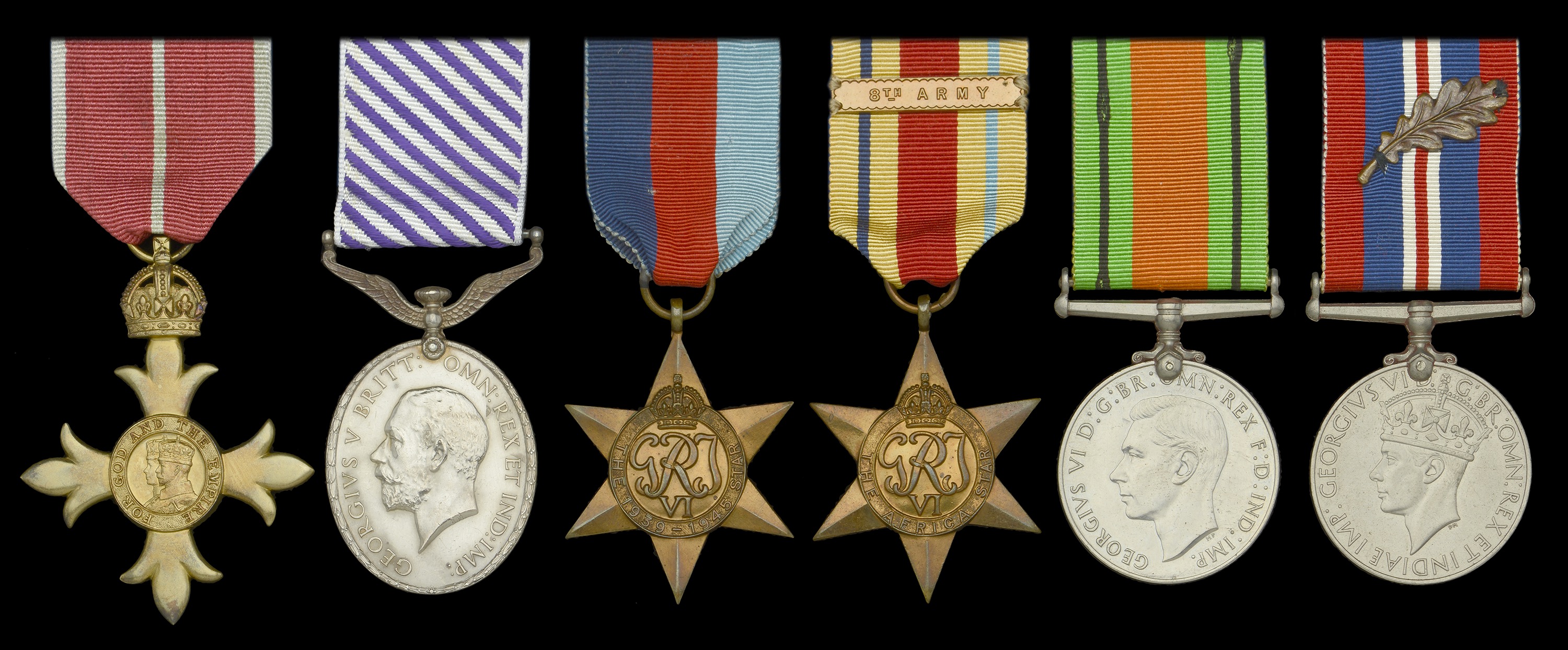A scarce and unusual Second War ‘1942’ military division O.B.E., ‘Iraq 1920-21’ D.F.M. group of six awarded to Aircraftman 1st Class, later Colonel, R. Hayne, Royal Air Force and Royal Army Ordnance Corps, who distinguished himself whilst serving with 30 Squadron over the newly formed Kingdom of Iraq, and stayed on in the Middle East for the inter-war years after his discharge. Obviously having made a success of himself, and now proficient in Arabic, Hayne re-engaged at Cairo for commissioned service with the R.A.O.C. during the Second War The Most Excellent Order of the British Empire, O.B.E. (Military) Officer’s 2nd type, breast badge; Distinguished Flying Medal, G.V.R. (39018 A.C.1. R. Hayne. R.A.F.); 1939-45 Star; Africa Star, 1 clasp, 8th Army; Defence and War Medals 1939-45, with M.I.D. oak leaf, mounted for display, generally good very fine (6) £2,000-£2,400 --- O.B.E. London Gazette 18 February 1943: ‘In recognition of gallant and distinguished service in the Middle East during the period May 1942 - October 1942.’ The original recommendation states: ‘This Officer has shown exceptional devotion to very responsible duties connected with fighting and other vehicles. He has also shown outstanding merit during two major reorganisations of his depot during a period of unprecedented activity and expansion. These high qualities have contributed considerably to the course of operations in the Middle East generally, and particularly during the present crisis in the Western Desert. He has set an inspiring example to all by his tenacity of purpose, organising ability, untiring efforts, leadership and absolute selfless service to the fighting troops.’ D.F.M. London Gazette 10 October 1922: ‘For distinguished services rendered during active Service operations in Iraq during 1920-21.’ M.I.D. London Gazette 1 April 1941: ‘For distinguished service in the Middle East during the period August 1939 - November 1940.’ Richard Hayne was born in Dorking, Surrey in January 1901, and entered the Royal Flying Corps as a Boy in July 1916. He was still mustered as a Boy on the formation of the Royal Air Force in April 1918, and is shown as being at the Recruits Depot on that date. Subsequent postings included C.F.S. Upavon, Eastchurch, No. 1 Aero Repair Department Farnborough, then again to C.F.S., and from there to 63 Squadron in Mesopotamia in July 1919. Hayne was posted as Aircraftman 1st Class to 30 Squadron (D.H.9A’s), Baghdad West, 1 March 1920, and it was for his service with the Squadron that he was awarded the D.F.M. The Squadron, commanded by Squadron Leader R. Collishaw, D.S.O. and Bar, D.S.C., D.F.C., was employed as one of the permanent squadrons in Iraq, engaged with providing security for the new kingdom. Hayne was posted to Amman, Trans Jordan in February 1922. The latter was the base for 14 Squadron and an Armoured Car Squadron. Hayne was transferred to the Reserve in January 1923, but more or less immediately recalled for Reserve Service, before finally discharged locally, 8 January 1924. Unusually, his address on discharge was given as ‘c/o Chief British Representative, Amman, Trans Jordan.’ Hayne appears to have decided that his civilian future lay in the Middle East, and he remained there throughout the inter-war years. Hayne was awarded a Regular Army Emergency Commission in the Royal Army Ordnance Corps in September 1939. He joined at Cairo, and declared his previous service with the R.F.C. and R.A.F., claiming linguistic talent in Arabic, but choosing to make no reference to his D.F.M. Hayne also provided proof of a Class ‘A’ Private Pilot’s Licence. He advanced to Temporary Colonel in October 1943, and served during the Second War in Egypt, Libya, Palestine, the United Kingdom and finished in Egypt. Hayne relinquished his commission, 26 March 1946, and was granted the Honorary Rank of Colonel. In later life he resided at 34 Cheniston Gardens, Kensington, London. It is unusual that Hayne did not declare his D.F.M. on entry into the Army, for he is known to have worn it after the Second World War. Indeed, he also wore a G.S.M., with ‘Iraq’ clasp which was named to a native - a medal to which he was not entitled. Hayne is not listed on the Iraq clasp medal roll, nor is there any reference to the award of the medal on his Record of Service (as a consequence the medal was removed from the group by the current vendor). His R.A.F. Record of Service, however, suggests that he was entitled to the BWM and VM (authorised on 8 January 1923 - the day before his discharge), but again this is incorrect. Hayne never saw service outside of the UK during Great War operations. Had he received them, he would surely have worn them, given his willingness to wear a G.S.M. to which he was not entitled! Sold with copied research.


